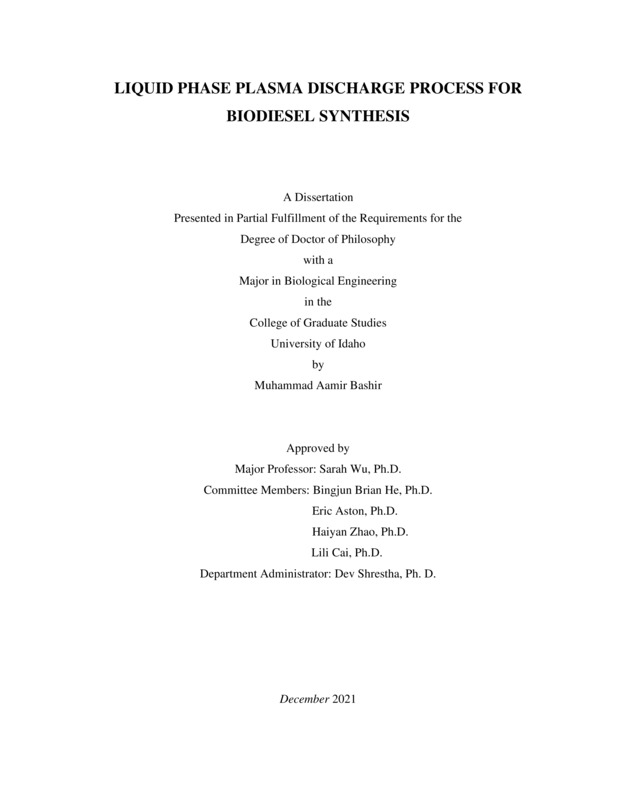LIQUID PHASE PLASMA DISCHARGE PROCESS FOR BIODIESEL SYNTHESIS
Bashir, Muhammad Aamir. (2021-12). LIQUID PHASE PLASMA DISCHARGE PROCESS FOR BIODIESEL SYNTHESIS. Theses and Dissertations Collection, University of Idaho Library Digital Collections. https://www.lib.uidaho.edu/digital/etd/items/bashir_idaho_0089e_12274.html
- Title:
- LIQUID PHASE PLASMA DISCHARGE PROCESS FOR BIODIESEL SYNTHESIS
- Author:
- Bashir, Muhammad Aamir
- Date:
- 2021-12
- Embargo Remove Date:
- 2023-12-21
- Program:
- Biological & Agricultural Engineering
- Subject Category:
- Chemical engineering; Bioengineering
- Abstract:
-
Due to the excessive consumption of fossil fuels, the ever-increasing population, and the deteriorating environment push people to search for alternative renewable fuels. Among the different types of renewable fuels, biodiesel (alkyl esters of fatty acids) obtained by transesterification of triglycerides and esterification of fatty acids can serve as a sustainable source of renewable energy. This work developed and investigated novel liquid plasma discharge processes that can be applied for biodiesel synthesis from oil or fatty acid-based feedstocks. A novel liquid phase plasma discharge (LPPD) reactor has been designed to overcome the challenges of mass transfer and power source requirement for non-thermal plasma discharge in liquid, and a second-generation LPPD processing system with or without argon gas flow has been designed and developed to continuously produce high-quality biodiesel from refined vegetable oils. The optimal conditions for transesterification of corn oil in the LPPD process was a dielectric opening size of 1.0 mm, oil to alcohol molar ratio (MOMR) of 8, liquid flow rate (LFR) of 2.7 mL/s, and NaOH catalyst loading ratio (NaOR) of 1.0 % (w/w), with a conversion rate of 99.5% obtained at an applied voltage of 1.2 kV in the continuous operational mode. The optimal conditions for transesterification in argon activated LPPD (Ar-LPPD) process was a dielectric opening size of 1.0 mm, MOMR of 7, LFR of 2.4 mL/s, argon gas flowrate (GFR) at 0.2 SL/min, and NaOR of 0.75 % (w/w), with a conversion rate of 99.8% achieved at the applied voltage of 40V in the continuous biodiesel synthesis. The oil to alcohol molar ratio and catalyst loading ratio were the most dominant factors controlling the triglycerides conversion rate in both LPPD and Ar-LPPD systems. The study also explored the reaction mechanism of transesterification of refined oil in plasma discharge systems to increase the energy efficiency of chemical reactions in the biodiesel synthesis process, which helps reduce biodiesel’s overall carbon footprint. The presence of free fatty acids (FFA) and water in triglycerides is one of the major challenges in transesterification. In Chapter 4, the LPPD system was developed and optimized using central composite design (CCD) with surface response methodology (SRM) for converting pure fatty acid (oleic acid) by esterification reaction in order to prepare the LPPD process for biodiesel production from high FFA feedstocks. The optimized operating parameters for the esterification reaction were found to be 2.4 mL/s for LFR, 10 for methanol to oleic acid molar ratio (MOMR), and 2.0 % for H2SO4 catalyst to oleic acid weight loading (CAT, w/w %), respectively, with the maximum conversion rate of 78 %. The power and applied voltage were consumed at 340 W and 2.12 kV during the 2-min treatment. However, the optimum conditions for esterification in the Ar-LPPD process were MOMR of 10, LFR of 2.4 mL/s, GFR of 0.2 L/min and CAT of 2 %, with which a fatty acid conversion rate of 86.8 % was obtained at the applied power of 150 W after 2-min treatment. Similar to the transesterification reaction, the oil to alcohol molar ratio and catalyst loading ratio were the most dominant factors in controlling the conversion rate in both LPPD and Ar-LPPD systems. The proposed reaction mechanisms and role of electron dissociation and reactive radicals generated in plasma for enhancing the reaction rate and the reaction pathways in the LPPD process are also discussed. The selection of an effective catalyst is critical to attaining a high conversion rate for biodiesel synthesis as the non-catalytic LPPD system showed low selectivity toward ester formation. Although homogenous acid and base catalysts have succeeded in esterifying and transesterifying fats and triglycerides, respectively, a group of heterogenous metal oxide catalysts were studied in Chapter 5 to evaluate the technical potential for reducing the cost and making the process more environmentally friendly. However, since the LPPD process was primarily designed for the liquid phase reactions where homogenous catalysts were effectively activated and achieved high product selectivity and conversion rates, the heterogeneous catalysts, compared to homogenous catalysts, showed limited capacity in catalyzing both reactions induced by the plasma discharge process. The maximum conversion yields for transesterification and esterification at the highest possible catalyst loading rate in the LPPD process were 7.32 % and 22.21 %, respectively, with Ni coated silica-alumina as the catalyst. In summary, it is suggested that the novel LPPD process developed in this work could potentially be a breakthrough in chemical engineering as a cost-effective process for both transesterification and esterification of triglycerides and fatty acids to synthesize sustainable liquid fuel at a commercial scale.
- Description:
- doctoral, Ph.D., Biological & Agricultural Engineering -- University of Idaho - College of Graduate Studies, 2021-12
- Major Professor:
- Wu, Sarah
- Committee:
- He, Bingjun Brian ; Aston, Eric ; Zhao, Haiyan ; Cai, Lili; Shrestha, Dev
- Defense Date:
- 2021-12
- Identifier:
- Bashir_idaho_0089E_12274
- Type:
- Text
- Format Original:
- Format:
- application/pdf
- Rights:
- In Copyright - Educational Use Permitted. For more information, please contact University of Idaho Library Special Collections and Archives Department at libspec@uidaho.edu.
- Standardized Rights:
- http://rightsstatements.org/vocab/InC-EDU/1.0/

